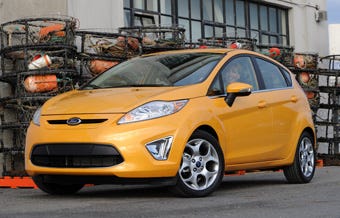Ford Expects Small-Car Demand to Rise, But Higher Fuel Prices Threaten Overall Market Growth
Even if gasoline prices subside, as they did following the spike in 2008, it’s unlikely there will be a shift away from small cars, Ford’s top sales analyst says.


Ford’s top U.S. sales analyst agrees the increasing gasoline costs likely will drive small-car sales, but admits there are concerns the rise in pump prices could have a chilling effect on the new-vehicle market overall.
“Higher gas prices take money out of consumers’ pockets,” says George Pipas at a recent gathering with journalists. “That means less money to spend somewhere else, which raises the specter it could derail (overall market) growth.”
Ford has been growing its U.S. market share steadily for more than a year and has posted consistent year-over year sales increases.
Pipas declines to predict whether gasoline pump prices will hit the $4 a gallon mark, last seen in the summer of 2008, calling such forecasting a “fool’s errand.”
Website LeaseTrader.com says during the summer of 2008, 78% of all consumers getting out of SUV and truck leases did so due to gasoline prices.
Today, with gasoline running $3.37 per gallon, according to the American Automobile Assn., just 16% of SUV and truck transfers are the result of fuel-price concerns.
“The average driver goes through a series of psychological stages when gas prices rise,” Sergio Stiberman, CEO and founder of LeaseTrader.com,” says in a statement. “During the uptick, concerns and complaints heat up when we pass certain price benchmarks, but widespread behavior doesn’t actually change until we reach $4.00 per gallon.”
If small-car demand increases as expected, Pipas says Ford is in a much better position this time around compared with 2008.

Ford Fiesta deliveries hit 6,270 in February, a monthly sales record for the B-car.
“For one, we didn’t have Fiesta two years ago,” he says. “Ford has 12 segment fuel-economy leaders, including four models over 40 mpg (5.8 L/100 km).”
February sales results released today indicate consumers already have begun flocking to small cars, as Fiesta deliveries hit 6,270, a monthly sales record for the B-car.
Even if gasoline prices subside, as they did following the spike in 2008, Pipas says it’s unlikely there will be a shift away from small cars.
“Baby Boomers are in a different life stage, and they account for 46% of (U.S.) sales,” he says. “(Boomers) don’t need as big a vehicle. The next biggest (generation) is Millennials, and they have a much higher level of unemployment.”
Another reason Pipas sees long-term growth for B- and C-segment cars: Owning a small car is an “insurance policy” against fluctuating gas prices.
When the U.S. government conducted the “Cash for Clunkers” program in 2009, it opened the door for owners of large vehicles to get into smaller ones. Many wanted to make that move a year earlier but couldn’t trade in their SUVs and other less-fuel-efficient models because of dismal residual values.
“Gas prices might stay the same or go higher. But no matter what, it’s going to cost you,” he says. “With large vehicles, you’re exposing yourself to things you can’t control, like gas prices.”
Rising gas prices have yet to take a chunk out of Ford’s overall U.S. light-vehicle sales, which jumped 13.0% to 153,592 units in February, according to Ward’s data.
Ford officials say they are pleasantly surprised by the success of the all-new ’11 Explorer SUV. After only a couple of months on the market, demand is outpacing supply.
In February, Explorer sales tallied 9,657, up 139.2% vs. year-ago when the last-generation model was on sale.
“We have fewer Explorers in dealer inventory at the end of February than we did at the beginning of the month,” Ken Czubay, Ford vice president-sales and marketing, says in a conference call with reporters and analysts.
“At the end (of February), we had 2,400 in inventory, which is only an 11 days’ supply. So we’ve taken steps to increase production at Chicago, where it is built.”
Czubay is adamant Ford is not leaving Explorer sales on the table due to limited supply, noting consumers are “waiting rather than leaving.”
And buyers are ordering high-contented Explorers. Pipas says the new model is selling for about $6,000 more per unit than the previous-generation Explorer.
In fact, Ford’s average transaction prices per unit are up across the board, he says. “Ford’s transaction prices in January and February were roughly 3% higher than the overall industry, which was basically flat.”
Also helping to bolster Ford’s bottom line was a 23% spike in retail sales last month. Fleet sales were about equal to year-ago, but less-profitable daily rental deliveries were down 15%.
Other Ford trucks also had a good month. Strong performers in February included the F-Series pickup, up 10.9% to 34,909, and the Econoline fullsize van, up 23.2% to 6,824. The Transit Connect small commercial van also saw a solid month with a 61.0% increase to 2,152.
Ford says it finished February with 410,000 vehicles in inventory, with 135,000 cars and 275,000 trucks.
Pipas says the auto maker intends to build inventory, announcing a 9% second-quarter production hike from year-ago to 710,000 vehicles, including 245,000 cars and 465,000 trucks.
About the Author
You May Also Like

